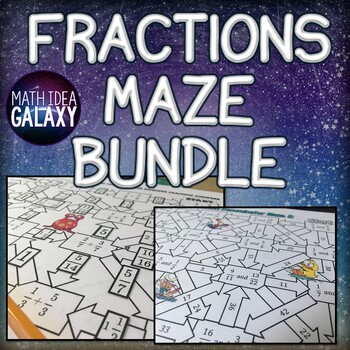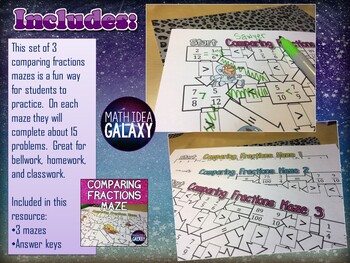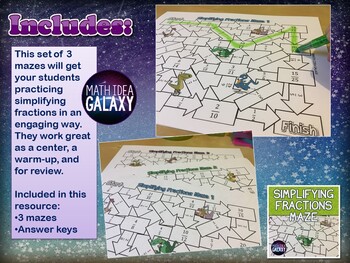Fractions Maze Bundle (Printable & Digital Resource)
Idea Galaxy
6.8k Followers
Resource Type
Standards
CCSS4.NF.A.2
CCSS4.NF.B.3a
CCSS4.NF.B.3c
CCSS5.NF.A.1
CCSS5.NF.B.3
Formats Included
- Zip
- Google Apps™
Pages
78 pages
Idea Galaxy
6.8k Followers

Includes Google Apps™
This bundle contains one or more resources with Google apps (e.g. docs, slides, etc.).
What educators are saying
The mazes are very well done and make great review activities. The digital versions are easy to use and the drag/drop arrows are bright and colorful.
Products in this Bundle (14)
showing 1-5 of 14 products
Description
Fractions Maze Bundle is a collection of 39 mazes and covers 13 concepts related to fractions including comparing fractions, converting fractions, adding, subtracting, multiplying, dividing, finding common denominators, simplifying and more. Your students will love completing these mazes for bell work, homework, or as a center activity.
***INCLUDES DIGITAL VERSION OF ALL MAZES IN GOOGLE SLIDES. EASY TO ASSIGN IN GOOGLE CLASSROOM OR OTHER LMS. ***
Includes:
- 39 mazes from 13 topics
- Paper and Digital Versions included
- Answer keys
Total Pages
78 pages
Answer Key
Included
Teaching Duration
3 Weeks
Report this resource to TPT
Reported resources will be reviewed by our team. Report this resource to let us know if this resource violates TPT’s content guidelines.
Standards
to see state-specific standards (only available in the US).
CCSS4.NF.A.2
Compare two fractions with different numerators and different denominators, e.g., by creating common denominators or numerators, or by comparing to a benchmark fraction such as 1/2. Recognize that comparisons are valid only when the two fractions refer to the same whole. Record the results of comparisons with symbols >, =, or <, and justify the conclusions, e.g., by using a visual fraction model.
CCSS4.NF.B.3a
Understand addition and subtraction of fractions as joining and separating parts referring to the same whole.
CCSS4.NF.B.3c
Add and subtract mixed numbers with like denominators, e.g., by replacing each mixed number with an equivalent fraction, and/or by using properties of operations and the relationship between addition and subtraction.
CCSS5.NF.A.1
Add and subtract fractions with unlike denominators (including mixed numbers) by replacing given fractions with equivalent fractions in such a way as to produce an equivalent sum or difference of fractions with like denominators. For example, 2/3 + 5/4 = 8/12 + 15/12 = 23/12. (In general, 𝘢/𝘣 + 𝘤/𝘥 = (𝘢𝘥 + 𝘣𝘤)/𝘣𝘥.)
CCSS5.NF.B.3
Interpret a fraction as division of the numerator by the denominator (𝘢/𝘣 = 𝘢 ÷ 𝘣). Solve word problems involving division of whole numbers leading to answers in the form of fractions or mixed numbers, e.g., by using visual fraction models or equations to represent the problem. For example, interpret 3/4 as the result of dividing 3 by 4, noting that 3/4 multiplied by 4 equals 3, and that when 3 wholes are shared equally among 4 people each person has a share of size 3/4. If 9 people want to share a 50-pound sack of rice equally by weight, how many pounds of rice should each person get? Between what two whole numbers does your answer lie?





